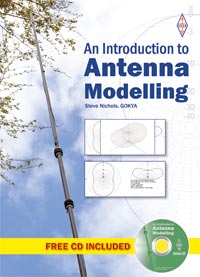 |
| The original design in my book for a flat-top optimised 40m OCFD (click for larger image). |
In my book
“Introduction to Antenna Modelling” I talk about how you can get
more bands out of a 40m off centre fed dipole (OCFD – sometimes
incorrectly called a Windom) by adjusting the feed point position.
The conventional
feed point is at the 33%/66% point, but if you do that with a 40m
OCFD (roughly 20m long) you find that you get 40m, 20m and 10m, but
15m offers a high SWR.
But the model shows
that by adjusting the feed point to 41% you can get a low SWR on 15m
too.
But this is just
theory – does it work in practice?
I thought I would
try it in real life and see how it performs. The only trouble is I
wanted to erect the antenna as an inverted V, so would that affect
the lengths and feed point in the MMANA-GAL model?
Anyway, after an
afternoon of fiddling with MMANA-GAL I ended up with an answer – an
antenna with a total length of 20.75m (8.5m and 12.25m for a 41%/59%
feed point), fed with a homemade twin core 4:1 balun and mounted at
about 8.5 metres, fed with about 25m metres of Mini8 coax.
The model I ended up
with suggested low-ish SWRs on 40 (actually, just over 3.1:1), 20, 15
and 10m, with not so good matches on 30m and 17m, as expected.
Now to turn it into
a real antenna. If you use PVC-coated wire, you'll end up with an
antenna that has to be shorter than calculated due to its velocity
factor being less than one. That is, the speed of light is slower in
a denser medium.
Every antenna I have
ever designed with MMANA-GAL has ended up shorter than calculated.
So applying an
estimated velocity factor of 95% I ended up with two legs of 8.075m
and 11.637m. I cut the wires a little longer than this and twisted
the ends over to allow for a little adjustment – I fully expected
to have to shorten the wires once it was up.
Having hauled it all
into position at the top of a fibreglass fishing pole I checked the
SWR at the end of the coax and was pleasantly surprised. It was
pretty much spot on, with an SWR less than 3:1 on 40, 20, 15m and 10,
and my internal ATU could also tune 30m and 17m, although obviously
its performance is down a little on those bands.
Lengthening it a
little might put the lowest SWR points a little more mid-band, but we
are only talking about fractions of one SWR point.
The model shows it
is a cloud warmer on 40m (good for NVIS contacts), and the multi-lobe
pattern on the higher bands is complex and not always ideal for DX,
but this is a compromise antenna.
Early tests have
been promising, with the antenna performance matching dedicated
dipoles on the bands on which it is resonant. So I think it is a
success.
Actual SWR
figures (at end of 25m of coax)
7.100MHz 1.9:1
10.120MHz 3.3:1
14.175MHz 2.5:1
18.100MHz 3.0:1
21.225MHz 1.2:1
24.940MHz 2.2:1
28.500MHz 1.4:1
Update: Well, I've been using it for a day and have worked Cuba (CO), Moldova (ER), Qatar (A71), Saudi Arabia (HZ) and Ceuta & Melilla (EA9) on 15m where it seems to go great guns. 40m has given strong contacts into Europe. I like it.
Update, February 2016
I've now been using the antenna for about four months so here is an update. It works very well on 40m, and is consistently equal to or down about 0.5 S point on my W5GI. I haven't used it much on 10MHz, but it looks to be slightly better than the W5GI. It works very well on 14MHz and 18MHz and is really good on 21MHz. Again, I haven't used it much on 12m, but it plays on 10m, although it is consistently slightly worse than a dedicated half-wave dipole by about 1-2 S points. Overall, not bad for a multi-band antenna.
As you can see below, someone asked about the balun. It is a Guanella design wound on two FT140-43 cores. Each core has about 13 turns (from memory) of twin loudspeaker wire.
The cores are then put back to back and wired with one side in series and the other in parallel. If the characteristic impedance of the twin wire is about 100 Ohms this gives the required 200 Ohms/50 Ohms = 4:1 impedance transformation.
The current thinking is Ferrite Type 61 for the top end of the HF range; Type 43 for the bottom end; or Type 31 for the best compromise across the range. The image is not of my balun but it is of a similar design. Mine is housed in a box with all the joints sealed with tape for waterproofing purposes.
Update: Well, I've been using it for a day and have worked Cuba (CO), Moldova (ER), Qatar (A71), Saudi Arabia (HZ) and Ceuta & Melilla (EA9) on 15m where it seems to go great guns. 40m has given strong contacts into Europe. I like it.
Update, February 2016
I've now been using the antenna for about four months so here is an update. It works very well on 40m, and is consistently equal to or down about 0.5 S point on my W5GI. I haven't used it much on 10MHz, but it looks to be slightly better than the W5GI. It works very well on 14MHz and 18MHz and is really good on 21MHz. Again, I haven't used it much on 12m, but it plays on 10m, although it is consistently slightly worse than a dedicated half-wave dipole by about 1-2 S points. Overall, not bad for a multi-band antenna.
 |
| A typical 4:1 two-core Guanella balun. |
The cores are then put back to back and wired with one side in series and the other in parallel. If the characteristic impedance of the twin wire is about 100 Ohms this gives the required 200 Ohms/50 Ohms = 4:1 impedance transformation.
The current thinking is Ferrite Type 61 for the top end of the HF range; Type 43 for the bottom end; or Type 31 for the best compromise across the range. The image is not of my balun but it is of a similar design. Mine is housed in a box with all the joints sealed with tape for waterproofing purposes.









Hi Steve,
ReplyDeleteThis antenna is in use by a lot of amateurs on the windom Yahoo group. In one form or another I have been using it since 2011. The weakness of it is a good SWR on both 40m and 20m is difficult.
I'd rather a simple centre feed doublet, match it up and off you go. That way, your losses are much, much less than coax, with any high SWR - of itself a lossless phenomenon - that will be encountered.
ReplyDeleteCould you share the model file?
ReplyDeleteJust paste this into a text file with a .maa extention:
Delete40m OCFD inverted V with 41% feedpoint 20.75m (8.5m/12.25m)
*
14.15
***Wires***
2
0.0, 0.0, 8.5, 10.95626, 0.0, 3.02069, 8.000e-04, -1
0.0, 0.0, 8.5, -7.95755, 0.0, 5.51212, 8.000e-04, -1
***Source***
1, 0
w2b, 0.0, 1.0
***Load***
0, 0
***Segmentation***
800, 80, 2.0, 2
***G/H/M/R/AzEl/X***
2, 1.0, 1, 200.0, 120, 60, 0.0
Hello Steve, I would be interested to hear about your twin toroid balun, eg size, material, windings. Thanks for the numbers on the split. David G3UNA
ReplyDeleteAnother great post, Steve. An OCFD is a great multiband solution for little extra effort.
ReplyDeleteYou mention 43 mix for low bands, 61 for HF high bands, and 31 as a compromise. Have you considered the 52 mix as a compromise material, instead of 31? It has lower loss than either 43 or 31, has a higher permeability than 61, and is available in a wider variety of sizes.